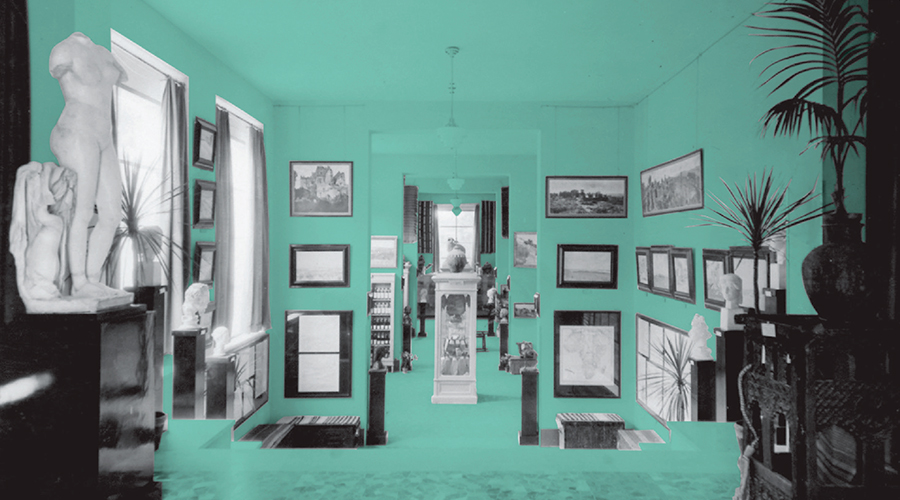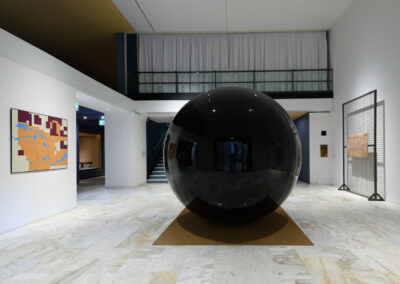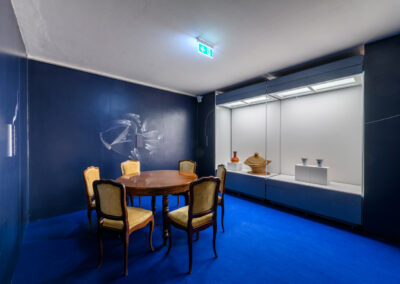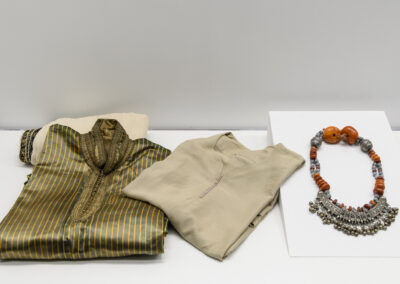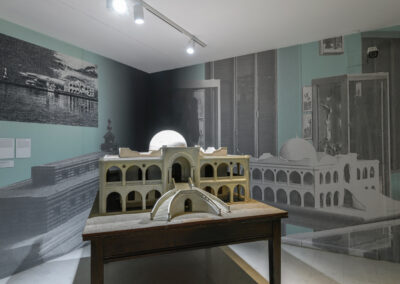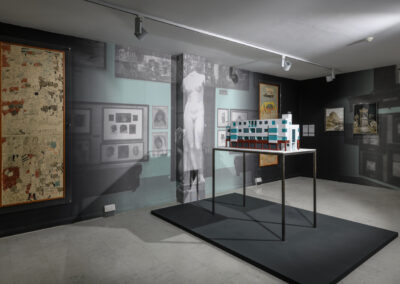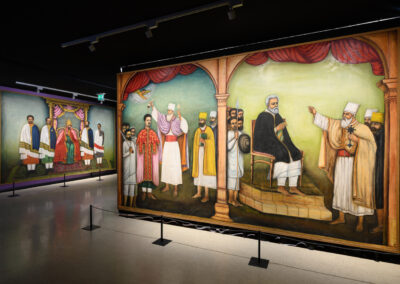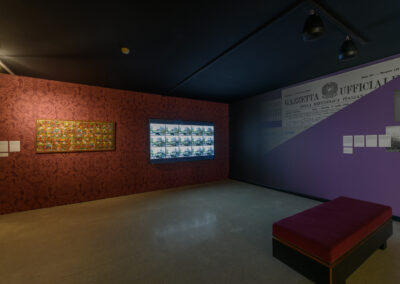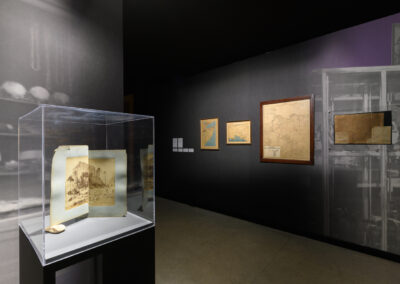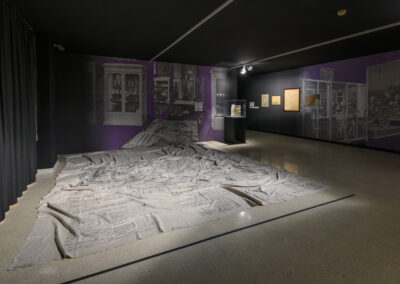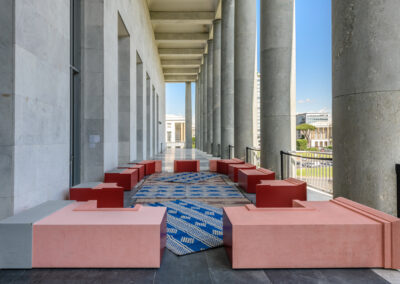– in progress
Museum of Opacities: Documenting the complexity of the colonial past, researching it in the present, sharing it for the future
Under the title of Museum of Opacities, the Museum of Civilizations presents a series of diverse and periodic displays of the Collections of the former Colonial Museum in Rome, whose permanent musealization is planned by 2026 with the support of the strategic Great Cultural Heritage Project funded by the Ministry of Culture. These collections, which entered the collections of the Museum of Civilizations in 2017, are currently being re-catalogued. As this work proceeds, different nuclei of works and documents will be periodically placed in dialogue with each other and with contemporary works, including new productions and acquisitions made possible by the Plan for Contemporary Art, promoted by the Ministry of Culture, as well as through residency processes, and by co-funding from the European Union Creative Europe program for the project Taking Care – Ethnographic and World Cultures Museums as Spaces of Care.
In this museum program, the title “opacity” takes on a double meaning: on the one hand referring to the opaque veil of amnesia fallen over the era of Italian colonial history, leaving its events and protagonists little known. On the other hand, opacity is that theorized by the poet and essayist Édouard Glissant (Sainte-Marie, Martinique, 1928 – Paris, 2011), whose writings have been fundamental to the development of contemporary post-colonial and de-colonial thought. In 1959, Glissant participated in the 2nd World Congress of Black Writers and Artists organized at the Italian Institute for Africa in Rome, which several years earlier had received responsibility for the collections of the former Colonial Museum. According to Glissant, opacity refers to the right of all individuals to free their identities of criteria such as “acceptance” or “understanding,” which amount to unilateral gestures of appropriation and classification, and rather to express themselves through “sharing,” which leads to assuming autonomous and specific identities, generated not by others but by oneself.
It is with this in mind that the Museum of Civilizations has decided to share its reflections with multiple stakeholders – citizens, collective groups and communities, artists, curators, researchers – on how to interpret and remount a selection of works and documents from the collections of the former Colonial Museum that testify to Italy’s nearly century-long colonial history in Africa (1882-1960), which were originally musealized with the propaganda function of constructing and supporting colonial imaginaries and policies. In equipping itself with plural and participatory research methods, the Museum of Civilizations first and foremost addresses its institutional responsibilities toward the approximately 12,000 objects – archaeological artifacts, art and craft works, merchandise, agricultural materials, scientific and technological instruments, maps and exhibition materials – that have remained in storage for more than 50 years, since the former Colonial Museum closed in 1971: an event that on the one hand contributed to the collective dismissal of Italian colonial history, and on the other to the need for its recontextualization in our present. What emerges is the regenerative potential of these same collections, once placed in dialogue with contemporary works of art and documents.
The Museum of Opacities is in fact based on this dialogue: by using photographs of the original stagings of the Colonial Museum as “anthropological evidence,” meaning in functions of critical memory, we can reconstruct the relationships between the objects and the linguistic and display devices that supported their interpretation, and at the same time trigger possibilities for new modes of documentation, research, and sharing. In particular, we gain the imaginative possibility of renegotiating the fundamental terms of past stories, projecting them into the future in order to return speech to the many subjectivities who were excluded from the exhibits and narratives of the former Colonial Museum, or who experienced the use of otherness to define a juxtaposition, rather than a dialogue between subjects and cultures. Opacity thus becomes a criterion not only for rewriting the history of the former Colonial Museum, investigating the mechanisms of its generation, but also to unleash the propulsive forces of new narratives that can contribute to the avoidance of any new Colonial Museums, and instead to spaces and times of sharing, and platforms for co-participation, encounter and confrontation.
The installations of the Museum of Opacities are subject to continuous updating. The first installations included the following works and interventions.
Placed in the museum entrance, the work የካቲት ፲፪ – Yekatit 12 by Jermay Michael Gabriel (b. 1997, Addis Ababa), acquired for the collection, opens the path of the Museum of Opacities by creating both a visual and historical short-circuit with the monumental staircase of the Palace of Sciences: in fact the work is a faithful copy of the 14-step monument built in Addis Ababa during the colonial period, as the symbolic insertion of the occupation of Ethiopia into the years of the fascist era. Continuing up the grand entry staircase, on the mezzanine, the visitor encounters a series of sketches by Francis Offman (b. 1987, Butare, Rwanda), which constitute the first working notes for a proposed future intervention operating in on-going confrontation with the architecture of the Palace of Sciences, and supplementing the perception of the large decorative apparatuses commissioned in 1942 for the never-inaugurated Universal Exposition of Rome.
The mezzanine overlooking the Collections of American Arts and Cultures presents three trans-temporal dialogues. The first room focuses on the theme of colonial appropriations through the study of a group of canvases taken from the Parliament of Ethiopia between 1936 and 1938, and only partially returned in the 1950s. Two works painted by Agegnehu Engida (xxx) are installed next to the video The Return of the Stele of Axum by Theo Eshetu (b. 1958, London), which narrates the long and complex process of restitution of the stele by the Italian state. Eshetu’s work also finds a new contextualization in its juxtaposition with the Battle of Adua, by unknown artists, and The Legend of the Queen of Sheba, by Balacciaw Yimar (xxx), with the latter evidencing the compositional canon of Ethiopian painting to which Eshetu’s video also refers. The second room focuses instead on Libya and on the relationships between colonial cartography and the erasure of the memories of a territory and its peoples, as emerges in the work The Green Mountain, now in the museum collection, by Adelita Husni Bey (b. 1985, Milan). The third room – just as in the former Colonial Museum, which housed a cinema for projection of newsreels – is transformed into a cinema, screening the documentary and visual essay Italian unconscious by Luca Guadagnino (b. 1971, Palermo), elaborating the historical images of the Istituto Luce as if these were a product of psychoanalysis, and bringing out a repressed collective from the unconscious.
The mezzanine overlooking the Collections of African Arts and Cultures projects the Museum of Opacity into the future, specifically the year 2154, in which the collective of Wissal Houbabi, Toi Giordani and Ismael Astri Lo imagine the opening of a house-museum of the diaspora, called ph0n0museum.rome. Here, the public will be able to view objects selected from colonial ethnographic collections by the Afro-descendant communities who participated in Houbabi’s artistic residency at the Museum of Civilizations in 2022-23 and who through the sharing of new narratives, thus lay the foundations of the imaginary and futuristic institution of ph0n0museum.rome.
Finally, the mezzanine above the Oceanian Arts and Cultures Collections delves into the structural relationships between art and propaganda that defined the former Colonial Museum. In particular, the exhibition itinerary evokes the Hall of the Arts, where the illustrated news-reporting by various Italian artists (such as Eduardo Ximenes, 1852-1932) supported the construction of an imaginary narrative of historical events. Exhibited alongside their works are those of Ethiopian and Eritrean authors, such as Alaqā Brahānē (xxx), who offer us a mirror version of the representation of the other liberated from colonial imagery. At the same time, Rossella Biscotti‘s (b. 1978, Molfetta) work on the Zeret massacre (1939), now in the museum collection, relates to the photos of the room honoring General Rodolfo Graziani, installed in the Colonial Museum in those same years: two versions of the same story. A work by Peter Friedl (b. 1960, Oberneukirchen, Austria) illustrates the legitimizing mechanisms of colonial imaginary, as does ongoing research by Bianca Baldi (b. 1985, Johannesburg) and Malak Yacout (b. 1993, xxx, Egypt), as well as the display of raw and processed materials from the doum palm, which became a key commercial commodity and whose history testifies to the resource-extractive logic characteristic of all colonial economies.
Installations by two Research Fellows of the Museum of Civilizations contribute to the opening of the Museum of Opacities.
Sammy Baloji (b. 1968, Lubumbashi, Democratic Republic of Congo) intervenes at the entrance to the Collections of African Arts and Cultures, with the installation Gnosis (2022), introduced into the collection and consisting of a large black fiberglass sphere that evokes and represents a reimagining of a 17th-century wunderkammer: in the manner of the spherical globe that typically adorned ancient studies and cabinets of curiosities. Baloji’s sphere, placed in the center of the room, absorbs and reflects all the surrounding images rather than returning a single one, as scientific cartography would instead dictate. The only map reflected in the work is that of Katanga, the artist’s home region, long the territory of greatest mining activity in the Democratic Republic of Congo. Also appearing in the reflections are two bronze plates (Fragments of Interlaced Dialogue [1], 2017) representing Kongo textiles preserved in the ethnographic collections of the Museum of Civilizations: like the video Of the Moon and Velvet, 2022, both works, introduced into the collection, manifest the epistemic systems encapsulated in the decoration of their inspiring ancient artifacts. Only today, thanks to de-colonial practices such as Baloji’s, do such objects speak again of the African gnosis, interweaving with its contemporary scenarios.
The DAAR art collective (Sandi Hilal, b. 1973, Bayt Sahur, Palestine; Alessandro Petti, b. 1973, Pescara), second of the Research Fellows, presents the project that won the Golden Lion at the 2023 Venice Biennale of Architecture. For their work Entity of Decolonization – Borgo Rizza, the collective received support from the 2021 edition of the Italian Council, a program of the General Directorate for Contemporary Creativity of the Ministry of Culture for the promotion of Italian contemporary art. The work is currently on long-term loan to the Museum of Civilizations from the Donnaregina Foundation for Contemporary Arts, Naples. Since 2021, the Entity of Decolonization has explored the possibilities of critical reappropriation, reuse and subversion of fascist-era Italian colonial architecture and its modernist legacy. The Borgo Rizza project analyzes a rural settlement built in 1940 by the Entity for Colonization of Sicilian Landholdings, whose function was to reclaim, modernize and repopulate inland Sicily, which the regime considered “empty” and backward, by adopting a design similar to that of colonial urban planning in Libya, Somalia, Eritrea and Ethiopia. The installation is a scale reproduction of the facade of the Borgo Rizza building, still present in Carlentini (Syracuse), which the artists break down into fifteen multipurpose modules, to be activated by assemblies who discuss the issues of decolonization. At the Museum of Civilizations, the modules will be in nomadic dialogue with the architecture of the two Palaces housing the Museum of Civilizations.
[1] Concept expressed by Germano Celant within the essay “Towards a Real and Contextual History” published in the catalog of the exhibition Post Zang Tumb Tuuum. Art Life Politics Italy 1918-1943, held at the Fondazione Prada in Milan from February 18 to June 25, 2018.

